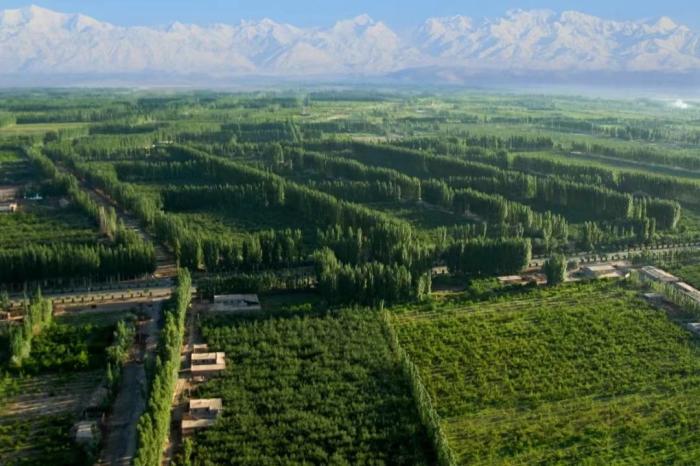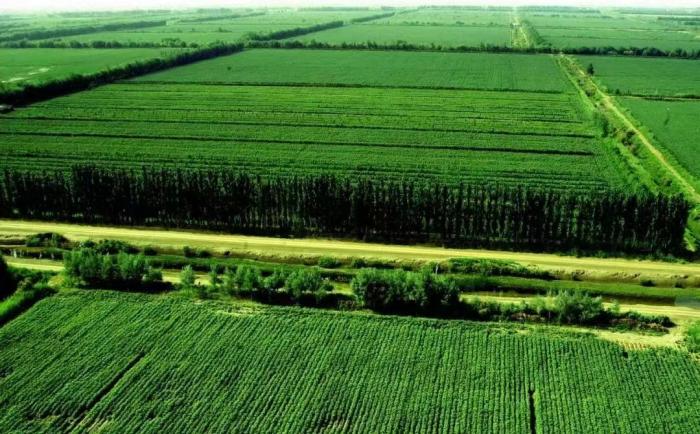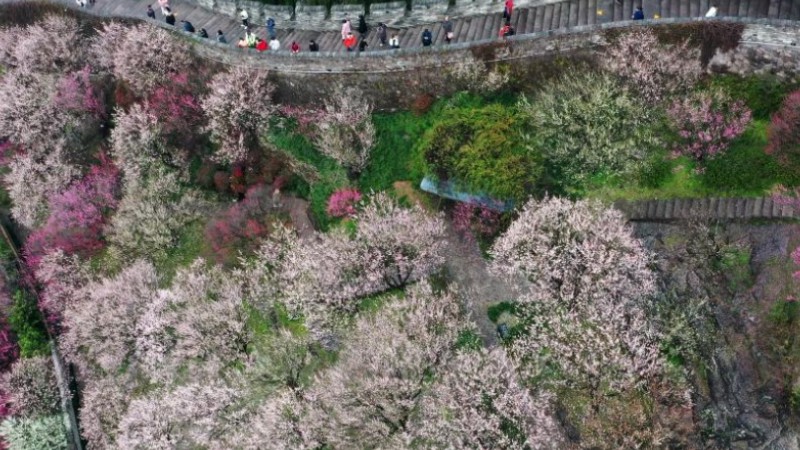'Afforestation miracle' brings happy lives to people in Aksu, NW China's Xinjiang
"Over 30 years ago, this part of the Gobi Desert was plagued by a harsh climate. It's because generations of people in Aksu persevered in afforestation efforts that we can have the happy life we enjoy today," said Li Hongrong, a resident of Aksu prefecture, northwest China's Xinjiang Uygur Autonomous Region.

Photo shows a part of a desert greening project in Kekeya township, Wensu county, Aksu city, Aksu prefecture, northwest China's Xinjiang Uygur Autonomous Region. (File photo)
Li, who runs an agritainment restaurant in his hometown, attributes the opportunity to benefit from the booming ecotourism sector in Aksu to a desert greening project implemented in Kekeya township, Wensu county, Aksu city of Aksu prefecture.
Aksu prefecture is located at the southern foot of the Tianshan Mountains and on the northern edge of the Taklamakan Desert in Xinjiang. Kekeya township is the main source of wind-blown sand in the urban areas of Aksu city and Wensu county.
In the 1980s, residents of Kekeya township were heavily impacted by wind and dust, and had to spend a quarter of the year in dusty weather, according to Song Xingnian, curator of the Kekeya Memorial Hall in Aksu.
The situation began to change in 1986, when the government of Aksu city launched the desert greening project in Kekeya, in a bid to eradicate the hazard of wind-blown sand.
"Planting trees in Kekeya was by no means easy! Every step, from digging ditches to building roads, levelling the land, and reducing the alkalinity of the soil, was as difficult as climbing up to the sky," said Song.
According to Song, the soil salt and alkali content in some parts of Kekeya was as high as 9.87 percent, significantly higher than the national standard of no more than 1 percent for afforestation, and the land was so hard that people had to use explosives to break it.
"People dug ditches and channeled snow-melt water from the Tianshan Mountains to reduce the soil alkali content. It would take 15 days to irrigate 100 mu (about 6.67 hectares) of land, and people would wear cotton-padded jackets and stay in the land day and night. The only food they had was three nangs per person per day," recalled Bao Wei, a staff member of the management station of China's Three-North Shelterbelt Forest Program in Kekeya. Nang is a kind of baked crusty pancake and a popular staple food in Xinjiang.
The painstaking efforts paid off. The large-scale afforestation project has miraculously converted desert into forests, and led Aksu prefecture onto a green development path to prosperity.

Photo shows a part of a desert greening project in Kekeya township, Wensu county, Aksu city, Aksu prefecture, northwest China's Xinjiang Uygur Autonomous Region. (File photo)
Over the past more than 30 years, people in Aksu have built a "Green Great Wall" that is 25 kilometers long from north to south and about 2 kilometers wide from east to west. They have accumulatively planted 48.5 million trees of various types, covering an area of more than 1.2 million mu.
The desert that used to bring so much trouble to locals has now been turned into a well-known fruit producing area in China, with its thin-skinned walnuts, apples, red dates, pears and other high-quality characteristic fruits enjoying great popularity across the country.
"We have planted a great number of fruit trees in the Gobi Desert, which has not only changed the desert, but also increased our incomes," said Wen Jianzong, a fruit farmer in Gebixincun village, Kekeya township.
By 2021, the total area of fruit trees in Aksu prefecture exceeded 4.5 million mu. Nearly 4.3 million mu of the trees had started to bear fruit, and the total fruit output in the prefecture reached close to 2.53 million tonnes. Meanwhile, Aksu prefecture's total area of fruit trees ranked second in Xinjiang, while its fruit output and output value ranked first in the region, and the income from fruit farming accounted for one-third of the disposable income of farmers in the prefecture.

Photo shows luxuriant trees on both sides of a road in Longkou village, Kekeya township, Wensu county, Aksu city, Aksu prefecture, northwest China's Xinjiang Uygur Autonomous Region. (File photo)
As the area of characteristic fruit trees continues to expand, companies specializing in deep processing of fruits have been drawn to Aksu prefecture. They not only buy and process local fruits, but have also provided jobs for and increased the incomes of local people.
“Aksu's high-quality agricultural and forest products and sound business environment have motivated us to keep investing in research and development here," said Zhao Wen'ge, general manager of a fruit-processing company in Xinjiang.
The company processes 50,000 tonnes of walnuts a year, and has provided jobs for more than 500 local people. Its annual sales value has reached 300 million yuan ($44.21 million).
Following the desert greening project in Kekeya, Aksu prefecture has implemented a number of other projects aimed at improving its ecological environment.
In 2021, Wensu county was listed among China's fifth batch of practice and innovation bases for the concept of "lucid waters and lush mountains are invaluable assets."
Looking at the trees in front of his house gave Maimaiti Tuohuti, a farmer in Lateleke village, in Aksu city, a greater vision of his hometown.
"I will actively take part in afforestation and plant more trees, so that my hometown will become more and more beautiful," he said.
"With higher humidity and fewer dusty days, Aksu city has almost become as liveable and beautiful as the regions south of the Yangtze River," he added.
Photos
Related Stories
- China's Xinjiang launches charter train service for cotton yarn supply
- Xinjiang becomes one of China's most popular winter tourism destinations
- Border cities showering with revival, hope after borders reopened
- Xinjiang plans to invest 8 bln yuan in rural road construction
- Xinjiang resumes regular flights to South Asia after three-year break
- Traditional fur snowboard craft flourishes through inheritance in Altay, NW China's Xinjiang
- Winter sports boom brings brighter future for Xinjiang residents
- Picturesque scenery of Kanas scenic area in Altay, NW China's Xinjiang
- Wondrous Xinjiang: Busy land ports herald thriving foreign trade
- Employees in cotton mill return to work in NW China’s Xinjiang
Copyright © 2023 People's Daily Online. All Rights Reserved.









